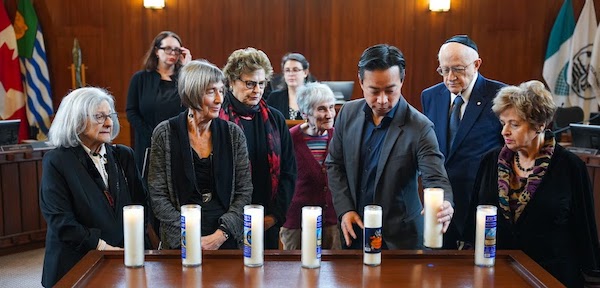Vancouver Mayor Ken Sim (third from right) lit memorial candles with Holocaust survivors (from left) Rita Akselrod, Amalia Boe-Fishman, Marie Doduck, Claude Romney, Peter Suedfeld and Ella Levitt. Behind are Nina Krieger of the Vancouver Holocaust Education Centre and Cantor Shani Cohen of Temple Sholom. (photo from VHEC)
Until 1943, Amsterdam’s Hollandsche Schouwburg theatre was used by the Nazis as a deportation centre for Dutch Jews. The youngest children were placed in a Jewish orphanage across the street. A tram would come at 10-minute intervals, providing a brief window of time during which the Nazi guards outside the theatre would lose sight of the orphanage.
The Dutch underground, in cahoots with the nurses at the orphanage, would smuggle babies and toddlers out of the orphanage during this fleeting moment. A member of the resistance would ride by on a bicycle pulling a garbage can and a nurse would pass a child through a ground-floor window into the receptacle and replace the lid.
One of those children was Peter Voormeij, who shared his Holocaust survival experience with a standing-room audience at the Bayit in Richmond, Jan. 29, marking International Holocaust Remembrance Day.
“My mother’s family were Orthodox Jewish and my father’s Roman Catholic,” he said at the event. Both families were against the union, partly due to the religious differences but perceived differences in social status were also a factor. “In any case, they got married and I was a result of their union.”
Soon after Peter was born, in late 1940, his father was arrested by the Nazis, suspected of being a spy, and was incarcerated at a Gestapo facility in Berlin.
Peter’s mother’s extended family fled into hiding, but his mother mistakenly believed that her marriage to a Catholic man, even an accused spy, provided her some security from deportations.
“She refused to wear the yellow star as was demanded of the Jews,” Voormeij recalled. “But a girlfriend of hers told the local police that she was a Jew, they confronted her and insisted that she should wear the yellow star. She did and, as a result, I clearly remember that we were not allowed in the park playground, which I was so looking forward to. No Jews allowed.”
He was only 2-and-a-half when he was separated from his mother. She was taken to Westerbork, the Nazi transit camp in the Netherlands, and transported by cattle car to Sobibor. “I often think of her alone, without her little boy, to have her beautiful blond hair cut and forced into a shower with many other women,” said Voormeij. “But no shower – gas.”
At the end of the war, Voormeij’s father returned to the Netherlands. Through his connections in the underground, he located his son, who had survived in hiding – and who, not yet 5, didn’t know he was a Jew.
Peter was raised for a few years by his beloved paternal grandmother. “There, I grew up in a Catholic household, went to a school attached to the church,” he said. “My memories of the time are reasonably good, albeit one time I was sexually molested by a [Catholic] brother – what else is new?”
When Peter was 12 years old, his grandmother died. He then returned to his father’s home, but now had a stepmother who he detested – and the feeling was mutual. One day, during a row, she yelled at him: “You are a typical Jew!”
“From that moment on, my life changed,” he said. “I realized that I am indeed a Jew. I looked at the church in a different way and I couldn’t understand why the Jews were persecuted and killed.”
However, he understood the implications of his new identity. “I became afraid of being a Jew and kept my mouth shut from then on,” he said. “Nobody will ever know that I’m a Jew.”
He indeed kept his identity largely secret. He excelled in school and received a scholarship to art school in Adelaide, Australia – four years with all expenses covered. He became a noted painter and art teacher, completing a master’s degree at what would become Concordia University, in Montreal, and later moving to New York City and back to the Netherlands. A turning point came in the early 1980s, during a conversation with a Dutch gallery owner who was to exhibit some of Voormeij’s work.
“She told me she despised the Jews,” he recalled. “At that point, something broke in me and I told her I was a Jew and left the gallery for good.”
He contacted his uncle, a brother of his mother who had survived by escaping to Switzerland. “My uncle introduced me to what it was like to be a Jew,” he said. “He gave me my first kippah and taught me some Jewish prayers. He also took me on my very first visit to a synagogue.”
At times, when he was alone with his uncle, he would ask about his mother. “I was dying to know more about her,” he said. “He was the only one that could remember. There was nobody else I could ask. Each time I brought her up, he would cry and I would cry with him while holding his hand.”
Eventually, Voormeij and his wife moved to British Columbia and he met a member of the Child Survivors Group that operates out of the Vancouver Holocaust Education Centre (VHEC). He joined and found a place among fellow child survivors.
The Jan. 29 event was the fourth annual commemoration of International Holocaust Remembrance Day in Richmond. It was co-sponsored by the Kehila Society of Richmond, the VHEC and the Jewish Federation of Greater Vancouver.
Rabbi Levi Varnai emceed the ceremony and spoke as a child of a survivor, noting that his grandfather was murdered when he was younger than Varnai is now. Cantor Yaakov Orzech recited the memorial prayer El Moleh Rachamim.
Parm Bains, member of Parliament for Steveston-Richmond East, brought a message from Prime Minister Justin Trudeau and the federal government. Kelly Greene, member of the B.C. Legislature for Richmond Steveston, brought greetings from Premier David Eby and the provincial government. Members of the Legislative Assembly, Henry Yao and Teresa Wat, were also in attendance. Richmond Mayor Malcolm Brodie spoke and four councilors – Bill McNulty, Chak Au, Andy Hobbs and Laura Gillanders – also attended.
Pascale Higham-Leisen, VHEC program coordinator, introduced Voormeij. Bayit president Keith Liedtke introduced the mayor, who noted that the day of the commemoration – Jan. 29, two days after the official International Holocaust Remembrance Day – was also the sixth anniversary of the mass shooting at a Quebec City mosque, in which six worshippers were murdered.
A smaller, invitation-only ceremony was held Jan. 27 at Vancouver City Hall. Vancouver Mayor Ken Sim lit memorial candles with six Holocaust survivors: Rita Akselrod, Amalia Boe-Fishman, Marie Doduck, Ella Levitt, Claude Romney and Peter Suedfeld. He also expressed condolences for a terror attack that happened earlier in the day at a Jerusalem synagogue, where seven people were killed. Bridges and buildings around the province were illuminated in yellow that evening to mark the memorial day.
Nina Krieger, executive director of the VHEC, which partnered with the Centre for Israel and Jewish Affairs and the Jewish Federation of Greater Vancouver to organize the civic event, thanked the assembled city councilors for recently adopting the International Holocaust Remembrance Alliance Working Definition of Antisemitism. Cantor Shani Cohen of Temple Sholom recited El Moleh Rachamim.




